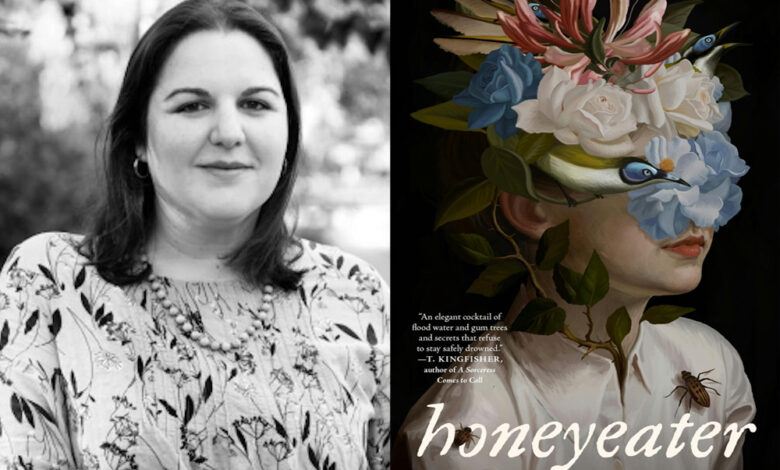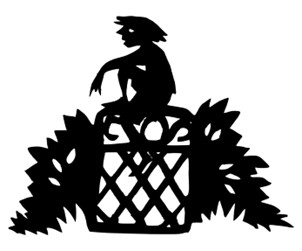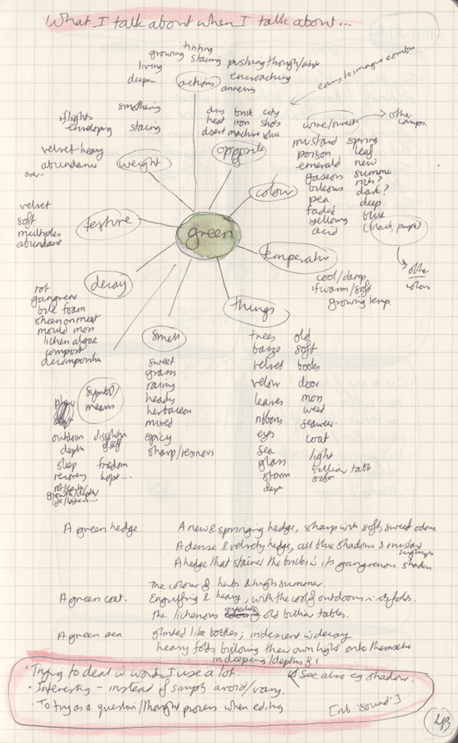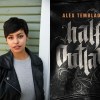Q&A: Kathleen Jennings, Author of ‘Honeyeater’

We chat with author Kathleen Jennings about Honeyeater, which is a richly imagined dark fantasy that pulses with the beautiful destruction of a town reclaimed by the natural world.
Hi, Kathleen! Can you tell our readers a bit about yourself?
I’m a writer and illustrator based in Brisbane, Australia, although I mostly grew up on a cattle property in Western Queensland, in a family that loved reading and reading aloud. I always wanted to write, but accidentally became a translator and lawyer along the way, and it took me a while to escape again! I finally (thanks to the encouragement of good friends and my eventual advisor and prolific author Kim Wilkins) got out by going back to uni to do some postgraduate study (on Australian Gothic and creative observation techniques). Honeyeater is my fourth book, but my first full-length novel (Flyaway was just — barely — technically a novella).
When did you first discover your love for writing and stories?
My family have always loved books and words — we used to read David Crystal’s popular linguistic books aloud, as well as novels! I got used to seeing the world around me through stories (a Western Queensland world through mostly English tales, admittedly, and so a lot of my writing involves working through that, its problems and possibilities). They became the framework for everything — even property and contract law were exciting for me because of how they resonate with fairy tales!
Quick lightning round! Tell us:
- The first book you ever remember reading: Little Red Riding Hood! But possibly only because my father read it to me 73 times before revolting. But Dolphin Crossing is in there fairly early. And lots of those slim little 1960s and ‘70s children’s novels with glorious sketchy pen-and-ink illustrations, that were still to be found in libraries.
- The one that made you want to become an author: The Voyage of the Dawn Treader (CS Lewis), which made me want to, and Deep Secret (Diana Wynne Jones), which made it feel possible. Travels and maps and meetings and encounters and coming home.
Your latest novel, Honeyeater, is out now! If you could only describe it in five words, what would they be?
Subtropical suburbia, too many ghosts.
What can readers expect?
Subtropical suburbia, too many ghosts! A beautiful, humid street, a corner of a suburb which refuses to grapple with either its past or future, neighbours who pull their chairs out into the street on nights when the creek is flooding and tell so many stories. And the rustles in the dark that might not be what you expect.
Some early notes on the elements of ghost stories. The shovel did get into Honeyeater.
Where did the inspiration for Honeyeater come from?
The inspiration for Honeyeater came first from Brisbane — the way the trees flowering over the streets make it feel like a Tiffany lampshade in certain seasons. Some of that became an early short story, trying to make that setting mythical (“The Splendour Falls”, now collected in Kindling: Stories). I knew I wanted to reach into that space again. But when I sat to write Honeyeater, that view of the city was overlaid by the 2011 floods (an excellent way to get to know the neighbours), and we were in lockdowns so I was mostly only seeing and walking through and noticing and sketching my own suburb. And then we had another flood in 2022. So the setting of Honeyeater, the suburb of Bellworth in the city of Gowburgh, was inspired by that. And Charlie and his problems (the sense of where water has been, the feeling of friends moving away and onwards without you), and the neighbours and the objects their stories are based around (wind chimes, wallpaper, second-hand vases, petrified wood, the things the creek holds) grew from the same place.
Were there any moments or characters you really enjoyed writing or exploring?
I really enjoyed exploring the physicality of one particular, invisible ghost! And I spent a lot of time noticing and experimenting and noticing again how to pull a sense of myth out of the apparently ordinary. And working out how to write and then thread through all the little ghost stories that begin the chapters, to complement and support the main story — finding a creepy situation that would hint at how sharehousing culture works, for example, in time for that to become relevant to the plot. Oh, and the taxi-driver’s daughter was a lot of fun to follow around Volney Street — I ended up drawing a little map of how she comes and goes (very rarely through a front gate).
Here is a little cut-paper silhouette I made of her, when I was working out the style for the internal ornaments.

Did you face any challenges whilst writing? How did you overcome them?
There were some big external challenges — I started working on it in 2020, so there was that, but then at the start of 2022 we had floods again. I made a little table of Big World Changing Events I Have Lived Through Already. It was actually quite reassuring to remember rodeos before the current one. Then, for each, I made various categories of notes which were revelatory for getting work done. But two particularly interesting categories that emerged were: good things that came out of this and sensory memories. Making those lists was grounding in the moment. But they were also really useful for the book itself — particularly sense memories of the floods, and the neighbourliness and closeness that came out of those disasters.
Another, lighter challenge was being called out on my shorthand words — particularly “green” and “(to) lean”. In those cases, I wrote down all the things I was using those words to mean: rotten or growing or humid or shady; comfortable or tall or weary or just some extra syllables before the next sentence. Then I worked on other ways to achieve those meanings: using contrasting colours to describe a shadow, the way a painter would, for example. I’ve written a bit about that process on my blog: green; lean.
Here are my “green” notes (discussed in more detail here):

What’s next for you?
I’m finishing the latest draft of the next book, about a house which should be haunted but isn’t! I’m also an illustrator, so keep your eye out for upcoming fantasy maps, silhouette cover art, etc. And of course, posting a lot of art, thoughts about writing, fairy-tale calendar pages and other items on tanaudel.wordpress.com.
Lastly, what books have you enjoyed reading this year? Are there any you’re looking forward to picking up?
I’m really enjoying reading the Emma Lathen (John Putnam Thatcher) murder mysteries from the ‘60s and ‘70s! And I’ve read some very fascinating old non-fiction, about bush schools (Hank Nelson’s With Its Hat About Its Ears), and several books about walking the length of rivers (Dart by Alice Oswald, Everything is Water by Simon Cleary). But in terms of recent fiction, the last three I read were Martine Kropkowski’s Left Behind, which I needed to sit and think about for a while because it isn’t a crime novel so much as a beach read for the end of the world (it comes out in October). I like books which make me have thoughts. Then there’s Jodie Matthews’ Meet Me At The Surface, all mud-slimed Cornish myth, and Amal El-Mohtar’s The River Has Roots, which is water and myth and doubtful definitions of death, so I appreciated that!
As for what I’m looking forward to reading: I have a box of old murder mysteries next to me, and I strongly suspect there is an unread Emma Lathen somewhere in there! And Martine’s book made me finally want to read the unrelated On the Beach (I adore Shute’s No Highway so I’m not sure why I’ve put it off). I’m really curious to read Wendy Wagner’s The Girl in the Creek, because we’ve been plucking on similar strings. And Angela Slatter, without whom very little I write would function half so well as it does, has A Forest, Darkly is out in February and I haven’t read it yet, which I usually would have!
Will you be picking up Honeyeater? Tell us in the comments below!
Source link


